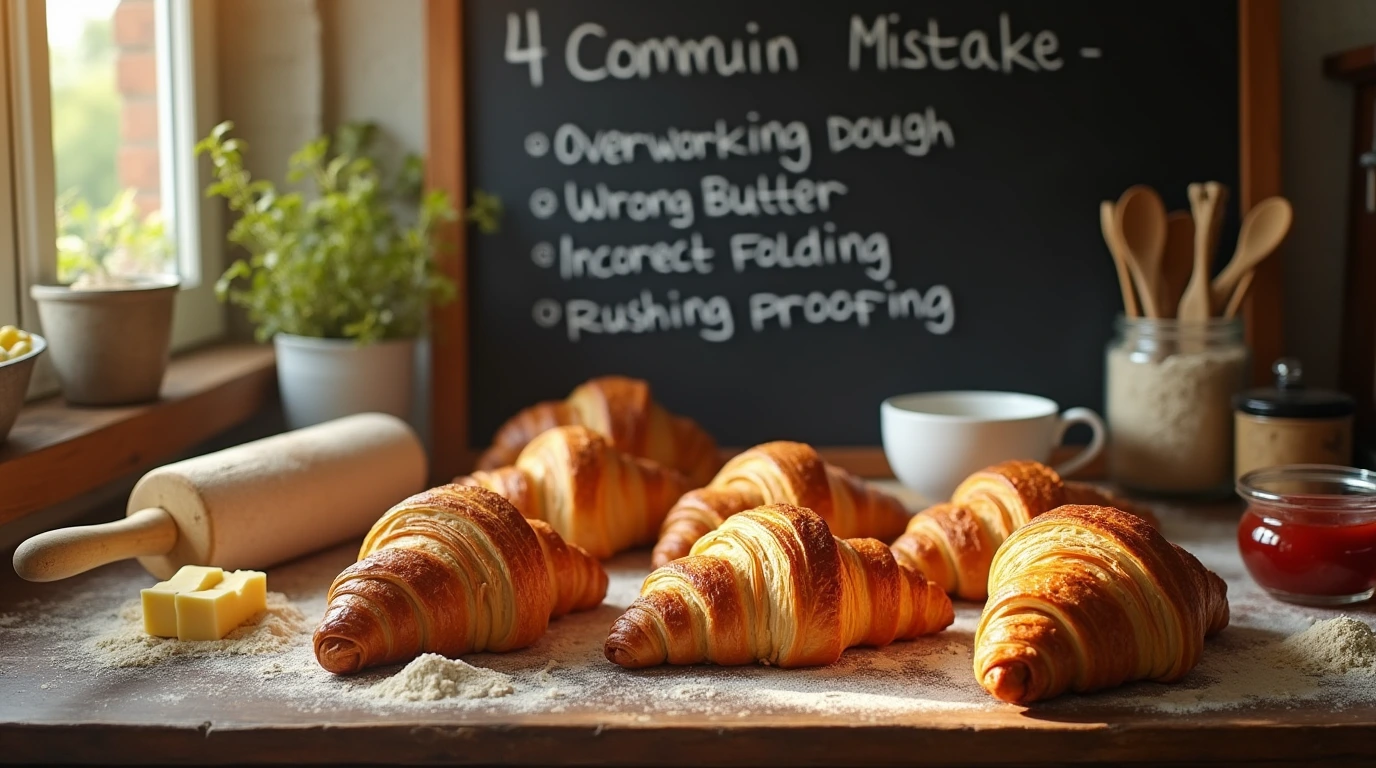Croissants are one of the most challenging pastries to master, requiring precision, patience, and the right techniques. But even experienced bakers can ask, what is a common mistakes in croissants? Errors like uneven lamination, improperly chilled butter, or rushing the proofing process can impact the final product, leaving you with croissants that are greasy, dense, or lacking layers.
In this guide, we’ll identify the most common mistakes in croissant baking, explain their effects, and share tips to help you achieve bakery-quality results at home. Whether you’re a beginner or a seasoned baker, this article will help you perfect your croissant game.
Why Making Croissants Can Be Tricky
To answer what is a common mistakes in croissants, it’s important to understand the challenges of maintaining consistent temperatures and techniques.
1. The Art of Croissant Baking
- Precision Required:
- Croissants rely on precise measurements, temperatures, and techniques. Even small deviations can affect the final product.
- Multi-Step Process:
- The process includes lamination, proofing, shaping, and baking—each requiring time and skill.
- Skipping or rushing any step can lead to disappointing results.
Pro Tip: Take your time with each stage and follow instructions carefully for the best outcome.
2. Common Challenges for Home Bakers
- Inconsistent Temperatures:
- Keeping the butter and dough at the same temperature during lamination is essential but tricky in a home kitchen.
- Limited Equipment:
- Unlike professional bakeries, home bakers may not have access to tools like dough sheeters or steam ovens, making it harder to achieve professional-quality croissants.
- Time Management:
- Croissants require several hours of preparation and resting time, making it easy to rush or skip steps.
Pro Tip: Use a marble rolling pin or chill your tools to maintain consistent temperatures during lamination.
Why These Challenges Matter
Croissants are as much about technique as they are about flavor. Recognizing the potential pitfalls helps you prepare for a successful baking experience.
The Most Common Mistakes in Croissants and How to Fix Them
If you’re asking, what is a common mistakes in croissants? Rushing the proofing process or uneven lamination are frequent culprits.
1. Not Chilling the Butter Properly
- The Mistake:
- Warm butter melts into the dough during lamination, ruining the flaky layers.
- Unevenly chilled butter can tear the dough during folding.
- The Fix:
- Keep the butter block and dough at the same temperature: cold but pliable.
- Chill between each fold for 20-30 minutes to maintain the right consistency.
Pro Tip: If the butter starts to melt, refrigerate the dough immediately before continuing.
2. Overworking the Dough
- The Mistake:
- Overkneading develops too much gluten, making the dough tough and hard to roll out.
- Overhandling during lamination can combine layers, reducing flakiness.
- The Fix:
- Knead only until the dough is smooth and elastic.
- Handle the dough gently during lamination to preserve the layers.
Pro Tip: Use light, even pressure with your rolling pin to avoid compressing the layers.
3. Skipping or Rushing the Proofing Process
- The Mistake:
- Underproofed croissants won’t rise properly, resulting in dense, doughy interiors.
- Overproofed croissants lose structure and collapse during baking.
- The Fix:
- Proof croissants at around 75°F (24°C) for 1.5 to 2 hours, or until visibly puffy and slightly jiggly.
- Avoid proofing in excessively warm environments, which can cause overproofing.
Pro Tip: Cover croissants with a damp cloth to prevent drying during proofing.
4. Uneven Lamination
- The Mistake:
- Failing to evenly distribute the butter during lamination leads to uneven layers and poor flakiness.
- Tearing the dough during folds can create gaps in the layers.
- The Fix:
- Roll out the dough evenly, maintaining consistent thickness across the entire surface.
- Ensure the butter block is square and evenly encased in the dough before starting folds.
Pro Tip: Mark fold directions lightly with your finger to maintain consistency throughout the process.
Why Fixing Common Mistakes in Croissants
Avoiding these errors ensures your croissants have the desired flaky layers, rich flavor, and light texture that make them irresistible.
Why Do These Mistakes Matter?
Understanding what is a common mistake in croissants helps bakers avoid errors that lead to dense or greasy pastries.
1. Impact on Flakiness and Layers
- Why It Matters:
- The hallmark of a good croissant is its flaky, layered texture. Mistakes like uneven lamination or warm butter can destroy these delicate layers, leaving you with a dense, bread-like pastry.
- How to Prevent It:
- Focus on proper lamination techniques and keep the dough and butter cold at all times.
Pro Tip: Visualize the layers as you fold and roll the dough. Aim for clean, distinct layers to maximize flakiness.
2. Changes in Texture and Flavor
- Why It Matters:
- Underproofed croissants can taste overly doughy and lack the light, airy interior. Overproofed croissants may collapse, resulting in uneven textures and muted flavors.
- How to Prevent It:
- Allow croissants to proof at the right temperature and duration to develop their structure and flavor.
Pro Tip: Proof the croissants until they are visibly puffy and slightly jiggly, indicating they’re ready for the oven.
3. Baking Challenges
- Why It Matters:
- Mistakes during preparation can result in uneven baking, greasy croissants, or burnt exteriors.
- How to Prevent It:
- Bake at the correct temperature, typically 375°F (190°C), and use an oven thermometer to ensure accuracy.
Pro Tip: Rotate the baking tray halfway through to promote even browning.
Why Attention to Detail Matters
Every step in the croissant-making process builds on the last. By avoiding mistakes, you ensure a balanced pastry that’s visually appealing, deliciously flaky, and perfectly buttery.
How to Achieve Bakery-Quality Croissants at Home
Creating croissants that rival those from a bakery requires patience, precision, and a few insider tips. Here’s how to elevate your homemade croissants to professional standards.
1. Mastering Lamination Techniques
- The Importance of Lamination:
- Proper lamination creates the flaky, airy layers that define a croissant.
- How to Master It:
- Ensure the butter block and dough are cold but pliable.
- Roll out the dough evenly to prevent tears and maintain layer integrity.
- Perform at least three folds (a book fold and two letter folds) to achieve enough layers.
Pro Tip: Chill the dough between folds for 20-30 minutes to keep the butter from melting.
2. Maintaining Consistent Temperatures
- Why It’s Crucial:
- Temperature consistency prevents the butter from melting into the dough, ensuring distinct layers.
- How to Achieve It:
- Work in a cool environment, ideally below 68°F (20°C).
- Refrigerate your rolling pin and tools if your kitchen is warm.
Pro Tip: If you notice the butter softening during lamination, refrigerate the dough immediately before continuing.
3. Perfecting the Proofing and Baking Process
- Proofing for Success:
- Croissants should proof in a draft-free environment at around 75°F (24°C) for 1.5 to 2 hours.
- They should double in size and jiggle slightly when moved.
- Baking for Even Results:
- Bake croissants at 375°F (190°C) for 15-20 minutes or until golden brown.
- Use a tray of water in the oven to create steam, which enhances the crust.
Pro Tip: Brush the croissants with an egg wash (1 egg mixed with a tablespoon of milk) before baking for a glossy, golden finish.
Why These Steps Work
Combining precise lamination, controlled temperatures, and proper proofing ensures your croissants will have the desired buttery flavor, flaky layers, and light texture.
FAQs About Common Mistakes in Croissants
Here are answers to common questions about croissant mistakes, helping you troubleshoot and perfect your baking techniques.
1. How Do You Fix a Croissant That Didn’t Rise?
- Why It Happens:
- Underproofing or inactive yeast can prevent croissants from rising properly.
- How to Fix It:
- Allow more proofing time in a warm, draft-free environment.
- Ensure the yeast used is fresh and activated.
Pro Tip: If the dough fails to rise after proofing, consider using it for a different pastry, like a flatbread or puff pastry tart.
2. Why Are My Croissants Greasy?
- Why It Happens:
- Melted butter during lamination or baking can make croissants greasy.
- How to Fix It:
- Maintain consistent cold temperatures during lamination to prevent butter from melting into the dough.
- Avoid overhandling the dough to keep layers intact.
Pro Tip: If your kitchen is warm, work in shorter intervals and refrigerate the dough often.
3. Can Overproofed Croissants Be Saved?
- Why It Happens:
- Overproofing causes the dough to collapse, leading to misshapen or dense croissants.
- How to Fix It:
- Bake overproofed croissants at a slightly lower temperature for a longer time to salvage texture.
- Next time, monitor proofing closely and adjust the timing based on your environment.
Pro Tip: Use an oven thermometer to ensure precise baking temperatures, especially for overproofed dough.
Why These FAQs Matter
Understanding these common issues and their solutions allows you to refine your techniques and avoid setbacks, ensuring consistently excellent croissants.
Conclusion: Avoiding Common Mistakes in Croissants
By now, you know the answer to what is a common mistake in croissants and how to perfect your baking techniques for buttery, flaky layers.
Making croissants is a rewarding challenge, and avoiding common mistakes ensures your effort results in buttery, flaky perfection. From mastering lamination to perfecting proofing, each step builds toward creating croissants that rival those from a professional bakery.
Key Takeaways
- Top Mistakes to Avoid:
- Improperly chilled butter, overworked dough, and rushed proofing are common culprits.
- Solutions for Success:
- Focus on maintaining consistent temperatures, precise lamination, and careful proofing to achieve bakery-quality results.
- Pro Tips:
- Use high-fat butter, chill between folds, and bake with steam for a glossy, golden crust.
For more inspiration, explore our Croissant Troubleshooting Guide or check out Baking Techniques for Perfect Pastries for additional techniques and inspiration.




